In the 6th century AD, the few copies of Archimedes’ surviving written works were compiled by Isidore of Miletus. Unfortunately, the references to his works that are not known today, which were made by the ancient mathematicians of Alexandria, suggest that some of his writings have been irretrievably lost. Archimedes is thought to have attached much greater importance to his theoretical considerations of mathematics and physics than his inventions of mechanical devices, because he did not seem to have left behind any records of the latter. But since he lived in the time of the Punic Wars, he developed war machines that greatly contributed to Syracuse resisting the Romans. Therefore, during his lifetime, his inventions of mechanical devices were much better known than his theoretical discoveries in mathematics and physics.
Archimedes died a tragic death at the age of 75 during the Second Punic War, when Roman forces captured Syracuse after two years of siege. According to Plutarch, a Roman soldier killed him while he was contemplating a mathematical diagram. Cicero, 137 years after Archimedes' death, wrote that he had found his tomb in a neglected state and restored it. According to Cicero, the grave was easy to identify because on top of it there was a tombstone with the figure of a sphere inscribed in a cylinder of the same height and diameter. Unfortunately, the location of Archimedes' tomb is unknown today.
